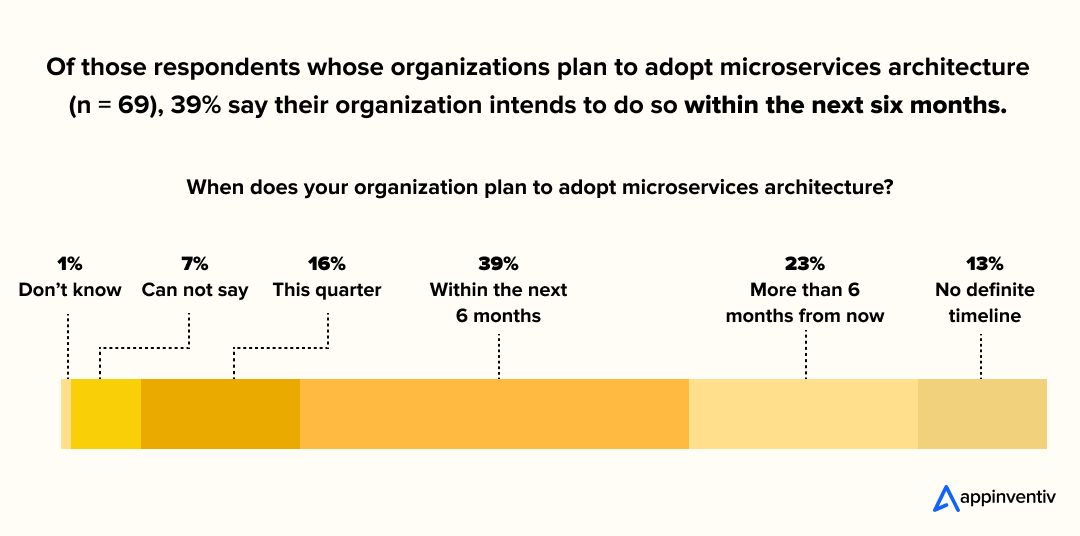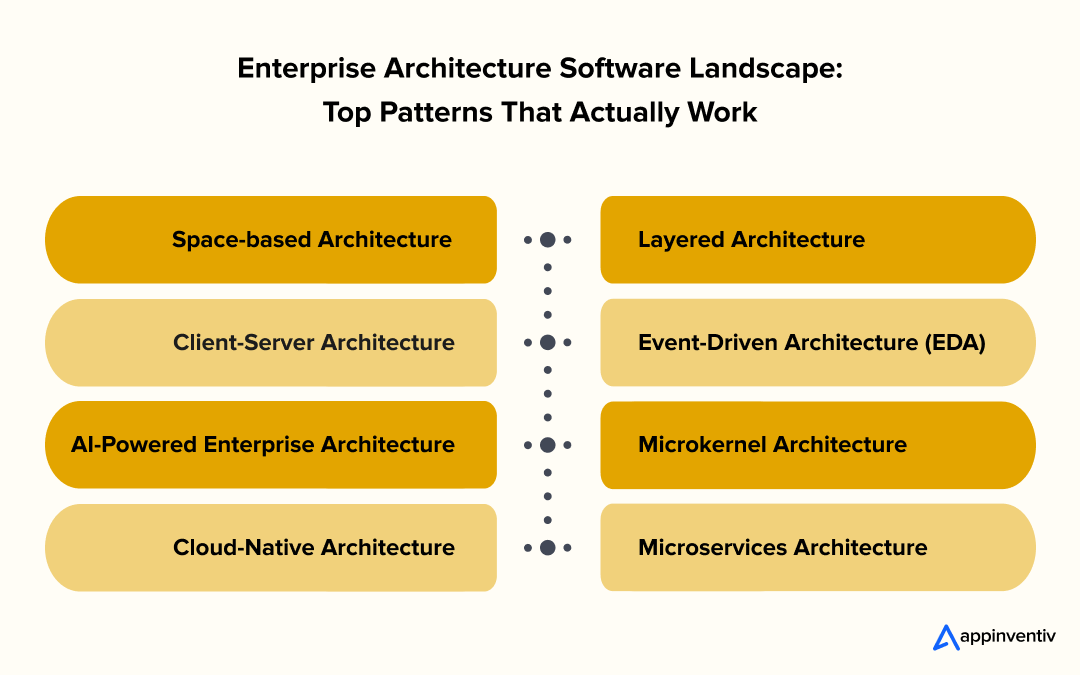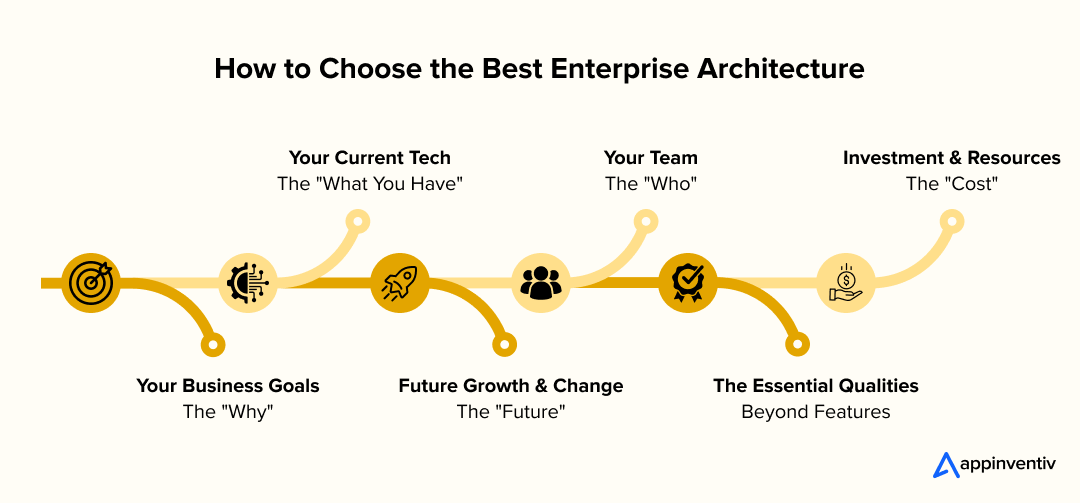- What Makes Enterprise Software Architecture Your Secret Weapon?
- The Pillars of Robust Enterprise Architecture
- Enterprise Architecture Software Landscape: Top Patterns That Actually Work
- Layered Architecture
- Event-Driven Architecture (EDA)
- Microkernel Architecture
- Microservices Architecture
- Space-based Architecture
- Client-Server Architecture
- AI-Powered Enterprise Architecture
- Cloud-Native Architecture
- Understanding the Core Layers of Enterprise Architecture
- How to Choose the Right Enterprise Architecture: Navigating the Architectural Compass
- Your Business Goals (The "Why")
- Your Current Tech (The "What You Have")
- Future Growth & Change (The "Future")
- Your Team (The "Who")
- The Essential Qualities (Beyond Features)
- Investment & Resources (The "Cost")
- Enterprise Architecture Best Practices
- Appinventiv: Your Trusted Partner to Choose the Best Software Architecture for Enterprise App
- FAQs
- Think of enterprise software architecture as your business’s very DNA. It’s the strategic core for growth, not just tech.
- Don’t just follow the crowd! Pick Software Architecture Patterns that genuinely fit your unique business goals for real impact.
- Your enterprise software architecture needs to be agile and ready for AI, IoT, and constant change. Future-proof your foundations!
- Smart software architecture decisions, often with a little expert help, truly save headaches and secure your long-term success.
Let’s talk about the very core of your digital enterprise — “software architecture”.
Imagine it as the very DNA of your digital business—every single architectural choice you make today isn’t just about getting a project off the ground; it’s about meticulously shaping how your entire organization will flourish, stretch, and contend in the ever-shifting winds of tomorrow. Would a master architect ever dream of raising a magnificent skyscraper without its meticulously drawn blueprints? Of course not! And so it goes with embarking on any significant enterprise application development: you simply must lay down the right architectural foundation first.
You see, this isn’t merely theory; it’s the lived reality of today’s tech landscape. Consider these compelling numbers: a significant 74% of organizations are already embracing microservices architecture, and a further 39% of those yet to adopt it are planning to jump in within the next six months (Source: Gartner). That’s a powerful current, isn’t it? And speaking of currents, by the end of 2025, we anticipate a staggering 85% of organizations will be operating on cloud-first principles

So, your enterprise software architecture choices aren’t just about fitting today’s shoes; they’re about strategically positioning your enterprise for that AI-driven, cloud-native future that, in truth, is already knocking on our door.
Schedule a strategic session with Appinventiv to align your technology foundation with current market demands.
What Makes Enterprise Software Architecture Your Secret Weapon?
Enterprise architecture software isn’t just technical infrastructure—it’s your competitive advantage disguised as code. When done right, it’s like having a perfectly orchestrated symphony where every component plays in harmony, creating something far greater than the sum of its parts.
Here’s why smart enterprises obsess over architecture:
- Developer Productivity: Clean architecture reduces debugging time, letting your teams focus on innovation instead of fixing broken systems
- Efficient Coding: A good software architecture pattern makes implementing the code easy and project coordination a seamless procedure.
- Business Agility: Well-designed architecture enables rapid feature deployment and seamless integration of new technologies like AI and IoT.
- Tech Stack Optimization: By identifying redundancies and inefficiencies, architecture helps streamline your systems, reducing technical debt and lowering IT costs.
- Cost & Time Optimization: Organizations using proper enterprise architecture report 20-30% gains in productivity and speed to market (PwC, 2025)
- Informed Decision-Making: With a comprehensive view of how systems, processes, and data interrelate, leaders can make faster, more informed decisions based on real-time insights
- Adherence to Resilience and Compliance: By establishing clear data flows and security controls, architecture helps detect vulnerabilities, maintain regulatory adherence, and ensure business continuity.
- Future-Proofing: The right architecture adapts as your business grows, preventing costly rewrites
The beauty of software development engineering is that you can integrate multiple architectural patterns within one system for optimization. However, selecting the ideal pattern for your enterprise demands careful consideration and, often, the guidance of seasoned development experts. This strategic choice is pivotal not just for immediate project costs but for the long-term growth and flourishing of your business through intelligent enterprise applications.
The Pillars of Robust Enterprise Architecture
When evaluating or designing any enterprise architecture software, it’s crucial to consider the foundational pillars that underpin a successful, future-ready system:
- Scalability: Can your architecture handle growth in users, data, and transactions without performance loss?
- Reliability: Does the system remain consistently available and recover gracefully from failures?
- Security: Are there robust safeguards to protect sensitive data and ensure compliance?
- Performance: Is the system optimized for speed and efficiency under varying workloads?
- Flexibility: Can the architecture adapt to new business requirements and integrate with emerging technologies?
- Maintainability: How easily can the system be updated, debugged, and improved over time?
Each architectural pattern (details below) addresses these pillars in different ways. As you evaluate your options, weigh each approach against these core criteria to ensure your architecture aligns with your business’s needs, both today and as you grow.
Enterprise Architecture Software Landscape: Top Patterns That Actually Work
Let’s cut through the noise and examine the architectural patterns that are actually driving business results in 2025, backed by real-world adoption benefits and potential drawbacks.

Layered Architecture
One of the most common and efficient models deployed by enterprises is the Layered Architecture, also called the n-tiered pattern. It packs similar components together in a horizontal manner and is self-independent. What does that mean?
It implies that the layers of the model are interconnected with each other but not interdependent. Similar components of enterprise application architecture remain at the same level, allowing the layers to be inadvertently separated based on the nature of the code.
For instance, the presentation layer handles user interfaces, the business logic layer manages application rules, and the data access layer interacts with the database.

This isolation is a cornerstone of its strength. If you decide to transition from an Oracle database to an SQL, the impact is primarily confined to the database layer, preventing a disruptive domino effect across the entire system.
Benefits of Layered Architecture
- Separation of Concerns: Each layer has a clearly defined responsibility, making the codebase easier to comprehend, maintain, and update.
- Maintainability: Developers can focus on a single layer, simplifying debugging and updates. Changes in one layer are less likely to ripple through others, provided interfaces remain stable.
- Reusability: Well-designed layers can be reused across different applications or projects, accelerating development.
- Scalability: Individual layers can be scaled independently based on load, optimizing resource allocation. For example, if user traffic surges, only the presentation layer might need additional resources.
- Easier Testing: Isolated layers facilitate more efficient unit and integration testing. (Source: Tencent Cloud)
- Enhanced Security: Security measures can be precisely implemented at each layer, controlling access to sensitive data and functions.
Potential Drawbacks:
- Larger applications tend to be resource-intensive if based on this format; therefore, for such projects, it is advised to overlook the layered pattern.
- Although the layers are independent, the entire version of the software is installed as a single unit. Therefore, even if you update a single layer, you would have to reinstall the whole apparatus all over again.
- Such systems are not scalable due to the coupling between the layers.
Ideal For
Enterprises that value structure, maintainability, and a clear separation of duties, and those seeking a robust, scalable foundation without excessive experimentation. It’s a particularly strong choice for traditional business applications and internal systems. In short, applications that do more than just CRUD (create, read, update, and delete) operations are suited to the layered architecture pattern.
Event-Driven Architecture (EDA)
The world, in its essence, is a cascade of events. A customer clicks a button, a sensor detects a change, a stock price fluctuates—these are all “events” that demand real-time attention. This is where Event-Driven Architecture (EDA) steps in. It’s a paradigm built to capture, process, and react to these crucial “events” as they unfold, enabling systems to communicate and act asynchronously.
In an EDA, applications operate on three key components:
- Event Producers: Applications or services that detect and publish events.
- Event Routers/Brokers: A mechanism (like Apache Kafka or AWS EventBridge) that receives events and filters them, pushing them to relevant consumers.
- Event Consumers: Applications or services that subscribe to specific events and react accordingly.

Benefits of Event-Driven Architecture
- Real-time Responsiveness: EDAs can monitor and react to events instantly, crucial for applications like fraud detection, real-time analytics, and dynamic pricing.
- Asynchronous Messaging: Producers publish events without waiting for consumers, allowing applications to move on to other tasks, simplifying integration, and improving overall system throughput.
- Decoupling and Loose Coupling: Services are independent, meaning they can be developed, deployed, scaled, and fail independently. This significantly enhances agility and system resilience.
- Scalability: Since services are decoupled, they can scale individually in response to event volume, preventing system-wide bottlenecks.
- Agility in Development: Teams can develop and deploy services more quickly without heavy coordination, accelerating the development process.
- Auditability: Event routers can provide a centralized location for auditing application behavior and defining policies.
Potential Drawbacks
- Developers may encounter bottlenecks when managing error handling, particularly in cases where multiple modules are responsible for a single event.
- You must use a recommended software architecture tool to back up the central processing platform. This is to deter the failure of a module from resulting in system collapse.
- The operational speed of the entire system could be slowed down if the processing platform is programmed to buffer messages as they come.
Ideal For
Event-driven architecture, the most popular enterprise software architecture and design, can be deployed for applications that leverage instant data communication that scales on demand. This includes e-commerce platforms (order processing, recommendation engines), IoT applications (sensor data processing), financial trading systems, and sophisticated data pipelines.
Microkernel Architecture
Also known as the plug-in architecture, the Microkernel pattern separates a minimal functional core (the “microkernel”) from extended functionality (the “plug-ins” or “extensions”). The most relatable example of the Microkernel Architecture would be any internet browser: the core browser provides basic browsing capabilities, while extensions (plug-ins) add features like ad-blockers, translation tools, or specific media players.
The microkernel remains small and stable, handling essential operations, while specialized features are implemented as independent plug-ins. This design promotes extensibility and adaptability.
Enterprise software development services rely on this pattern for designing large-scale, complex applications as well. An example of such a business application could be a software for processing insurance claims.

Benefits of Microkernel Architecture:
- Extensibility: New features can be added by simply developing and integrating new plug-ins without altering the core system.
- Flexibility: The system can be customized by selecting and configuring specific plug-ins for different needs.
- Maintainability: The small core is easier to maintain, and plug-ins can be updated or replaced independently.
- Scalability (of features): Specific functionalities can be scaled by optimizing their respective plug-ins.
Potential Drawbacks
- For large systems with numerous plug-ins, managing their interactions, versions, and governance can become challenging.
- Communication between the microkernel and plug-ins might introduce some overhead.
Ideal For
Applications that require a high degree of adaptability and extensibility, such as integrated development environments (IDEs), operating systems, web browsers, and product lines where core functionality is consistent but specific features vary.
Microservices Architecture
Microservices Architecture is a self-regulating and independent codebase in modern application development, particularly for complex, scalable systems. It breaks down a large, monolithic application into a collection of small, self-contained, and independent services. Each service is responsible for a single business capability and can be developed, deployed, and managed independently by small, dedicated teams.
Consider a large e-commerce platform. Instead of a single massive application, it would consist of separate microservices for user authentication, product catalog, shopping cart, order processing, payment gateway, and other related services. These services communicate via lightweight mechanisms, typically APIs.
Microservices Architecture enables developers to release software versions through the sophisticated automation of software building, testing, and deployment – a key differentiation point between Microservices and Monolithic architecture.

Benefits of Microservices Architecture:
- High Fault Tolerance: If one microservice fails, the entire application doesn’t collapse. Other services continue to function, ensuring greater system resilience.
- Independent Scalability: Services can be scaled independently based on demand. A heavily used feature can scale without impacting less-used parts of the application.
- Technology Diversity: Different microservices can be built using different programming languages, frameworks, and databases, allowing teams to choose the best tools for each specific task.
- Faster Deployment: Smaller, independent services mean faster development cycles, easier testing, and more frequent deployments.
- Agile Development: Small, cross-functional teams can own a service end-to-end, fostering agility and accountability.
Potential Drawbacks
- Since each service is unique in its ability to contribute to the overall codebase, it can be challenging for an enterprise mobile application development company to integrate all these services seamlessly and operate them effectively.
- Developers must define a standard protocol for all services to adhere to. It is essential to do so, as the decentralized approach to coding microservices in multiple languages can pose significant issues during debugging.
- Each microservice, with its limited environment, is responsible for maintaining the integrity of the data. It is up to the architects of such a system to devise a universally consistent data integrity protocol, wherever possible.
Ideal For
Complex, large-scale applications require high scalability, continuous delivery, and the ability to evolve rapidly. Companies like Netflix, Amazon, and Spotify are prime examples of successful microservices adoption. It is particularly well-suited for applications where certain segments experience sporadic bursts of high usage.
Space-based Architecture
Space-based Architecture, also known as Tuple Space or Cloud-based Architecture, is designed to handle extremely high loads and variable concurrent user volumes by distributing both processing and storage across multiple servers. It’s built on the concept of a shared, distributed memory space (the “tuple space”) that allows different processing units to communicate and share data asynchronously without direct coupling.
An ideal example of this type of enterprise software architecture is a bidding auction site. The users place bids on the site through a browser request. Once the request is received, the site records the bid with a timestamp, updates all the information related to the latest bid, and sends the data back to the browser.

Benefits of Space-based Architecture:
- Exceptional Scalability: It excels at addressing concurrency and scalability challenges, making it ideal for applications with unpredictable user loads.
- High Performance: By operating primarily in-memory, it offers extremely fast data access and processing.
- Resilience: The distributed nature allows the system to continue functioning even if individual nodes fail.
Potential Drawbacks
- While good for high-volume, low-value data (where occasional loss is tolerable), transactional support for high-value data can be complex with in-memory databases.
- It could be challenging to generate enough load to test the system, but testing the individual nodes independently is easy.
- Developing skills to cache data for speed is difficult without corrupting multiple copies
Ideal For
Applications with extremely high and unpredictable concurrent user volumes, such as online gaming, real-time bidding systems, financial trading platforms, and large-scale collaborative applications.
Client-Server Architecture
It is a modern enterprise software architecture comprising two main components: the client (the consumer) and the server (the producer). The server acts as the producer, and the client acts as a consumer. This architecture facilitates communication between the client and server, irrespective of whether they are on the same network or not. A client requests specific resources to be fetched from the server in the form of data, content, or files. The server responds to the client’s requests appropriately by sending over the requested resources.
Client-server architecture is quite flexible, as a single server can support multiple clients, or a single client can use multiple servers.
The best example of this architecture is Email. When a user searches for a particular email, the server retrieves the requested email resource from the pool of resources and sends it back to the user/client.

Benefits of Client-Server Architecture:
- Centralized Control: The server can manage and store data centrally, allowing for easier security management, backups, and access control.
- Scalability: A single server can support multiple clients, and the server itself can be scaled to handle increased load.
- Distributed Functionality: Clients and servers can be optimized for their specific roles, improving overall system performance.
- Maintainability: Updates can often be deployed on the server without requiring changes on every client, simplifying maintenance.
- Cost-Effective: Centralized resources can be shared among many clients, potentially reducing hardware costs per user.
Potential Drawbacks
- If the central server fails, all clients relying on it will be affected, though modern implementations often mitigate this with redundancy.
- Requires a stable network connection between the client and server.
- A single server can become a bottleneck if too many clients make requests simultaneously, necessitating load balancing and scaling strategies.
Ideal For
It is ideal for applications that focus on real-time services, such as telecommunication apps. Applications that require controlled access and offer multiple services to a large number of distributed clients can utilize this architecture.
AI-Powered Enterprise Architecture
In 2025, artificial intelligence isn’t just a clever feature we sprinkle into our applications; it’s rapidly becoming a fundamental force that shapes the very bones of our enterprise software architecture. Imagine your architecture not as a static blueprint drawn once and then merely maintained, but as a living, learning entity. This is the promise of AI-powered enterprise architecture.
Here, AI isn’t simply running within your apps; it’s actively involved in designing, optimizing, and even self-healing the architectural fabric itself. We’re talking about AI-driven systems that can autonomously detect anomalies, predict potential bottlenecks before they cause trouble, optimize resource allocation across your entire infrastructure, and even bolster security with intelligent, adaptive defenses. It’s a profound shift from a fixed design to a dynamic, intelligent system that continuously adapts and improves, almost like a truly intelligent nervous system for your digital enterprise.
Benefits of AI-Driven Architecture
- Effortless Optimization: AI can tirelessly fine-tune your system’s performance, resource usage, and even operational costs, making your architecture remarkably efficient without constant human tweaking.
- Predictive Foresight: It’s like having a digital oracle! AI can foresee potential issues – whether it’s a looming bottleneck or a hardware hiccup – giving you the chance to fix them before they become problems.
- Fortified Security: AI acts as a vigilant guardian, enhancing threat detection and enabling rapid, intelligent responses to cyber dangers, making your system tougher to breach.
- Accelerated Creation: Imagine AI assisting in generating code snippets, automating rigorous testing, or even recommending the most suitable software architecture design patterns for a new module. It speeds up development remarkably.
- Self-Adapting Systems: The ultimate goal: an architecture that learns from its environment and adapts to changing demands without constant manual intervention, a truly agile and resilient digital organism.
Potential Drawbacks
- AI models, like discerning connoisseurs, demand vast amounts of high-quality, relevant data to learn and perform effectively. Without it, their wisdom is limited.
- As AI makes more autonomous decisions, we must grapple with potential biases in its learning, and ensuring transparency in its operations becomes paramount.
- Finding professional AI developers who possess deep expertise in both enterprise architecture applications and the nuances of AI/Machine Learning can be quite challenging.
Ideal for
Organizations wrestling with incredibly complex, large-scale systems that crave continuous optimization, proactive problem-solving, and enhanced security. Think major financial institutions, sprawling IoT ecosystems, massive e-commerce platforms, or smart city initiatives. Essentially, anyone aiming for a truly “self-managing” and hyper-efficient IT landscape.
Also Read: AI in Architecture: Key Benefits & Use Cases for Businesses
Cloud-Native Architecture
When we speak of “the cloud” in 2025, we’re often not just talking about renting servers somewhere else. We’re talking about Cloud-Native Architecture: a philosophy, a mindset, and a powerful set of software architecture best practices for building and running applications designed to thrive in modern cloud environments. It’s about leveraging the cloud’s inherent strengths to their absolute maximum.
This approach wholeheartedly embraces principles like breaking down large applications into nimble microservices, packaging them into portable containers (think Docker and Kubernetes), and utilizing serverless functions that spring to life only when needed. It champions immutable infrastructure (meaning, once built, it’s never changed, only replaced) and relies on declarative APIs to describe desired states rather than sequential commands. In essence, it’s no longer just an option; it’s rapidly becoming the default architecture for enterprise applications striving for true agility, resilience, and cost-effectiveness in this new digital era.
Also Read: Why should businesses choose serverless architecture
Benefits of Cloud-Native Architecture
- Unprecedented Scalability: Cloud native application architecture can effortlessly expand and contract like a breath, scaling resources up and down automatically with demand. This elasticity is crucial for any scalable software architecture for an enterprise.
- Built for Resilience: Cloud-native applications are designed from the ground up to gracefully handle failures. If one part falters, the rest carries on, often self-healing without human intervention.
- Blazing Fast Innovation & Deployment: Thanks to automated CI/CD pipelines, smaller, independent deployments, and rapid iteration cycles, you can bring new ideas to life and deploy them incredibly quickly.
- Smart Cost Efficiency: The “pay-as-you-go” model and highly optimized resource utilization mean you often only pay for what you truly use, making it remarkably cost-effective in the long run.
- Empowered Developers: A rich ecosystem of tools and platforms simplifies many operational complexities, allowing developers to focus more on creating value and less on infrastructure wrangling.
Potential Drawbacks
- Relying heavily on specific services offered by a single cloud provider can sometimes make it tricky to move your applications elsewhere later on.
- While simplifying development in some ways, managing a vast, distributed cloud-native environment can introduce its own set of operational challenges.
- Distributed Security Landscape: With components spread across various cloud services, ensuring a consistent and robust security posture across your entire distributed system requires careful planning and constant vigilance.
Ideal for
Any organization aiming for maximum agility, boundless scalability, and robust resilience. It’s the go-to choice for startups, fast-growing businesses, and established enterprises undertaking serious digital transformation. If you’re building new applications from scratch or thoughtfully modernizing existing ones, cloud-native is increasingly the unquestionable architecture for enterprise app development.
Understanding the Core Layers of Enterprise Architecture
No matter which architectural pattern you choose, most systems share a common heartbeat, a foundational set of distinct “layers.” Think of them as the essential floors of your digital building:
- Presentation Layer: This is the very face of your app, what users see and interact with. It’s their window into your digital world.
- Business Logic Layer: Here’s where the real thinking happens! All your core rules, calculations, and vital workflows are processed right here, the brain of your operation.
- Data Access Layer: Consider this your diligent librarian, managing all the chatter with databases, ensuring data is neatly stored and retrieved when needed.
- Integration Layer: Ever wonder how your system talks to the outside world? This is the diplomat, connecting your app with external services, APIs, and even those trusty old legacy systems.
- Infrastructure Layer: The underlying servers, networks, and cloud resources that support your application.
Mapping your chosen Software Architecture Pattern to these layers just makes things clearer. It truly ensures a clean, easily managed design.
How to Choose the Right Enterprise Architecture: Navigating the Architectural Compass
Choosing the perfect enterprise architecture application isn’t about finding a magic “one-size-fits-all” solution. It is far more nuanced. It’s about carefully aligning that architectural blueprint with your organization’s unique dreams, its current strengths, and its grand future ambitions. This isn’t just a tech decision; it’s a strategic one. So, how do we navigate this crucial choice? Here’s how to navigate this crucial decision:

Your Business Goals (The “Why”)
Before you even glance at a technical diagram, ask yourself: What are we truly trying to achieve? Is it lightning-fast innovation, perhaps drastically cutting costs, or handling an explosion of users worldwide? Do you dream of real-time responsiveness, or is rock-solid security your absolute non-negotiable? Understanding these fundamental aspirations will guide you in selecting the software architecture design patterns that best align with your business’s core values.
Your Current Tech (The “What You Have”)
What systems are already humming along in your enterprise? What technologies are your teams most comfortable with? This insight will powerfully influence which enterprise system architecture patterns are truly feasible and practical for your next big step.
Future Growth & Change (The “Future”)
Will your application need to smoothly handle millions of users next year? Are new features going to be rolling out weekly, or even daily? For true growth, you need a scalable software architecture for enterprises that won’t buckle under pressure. Architectures like Microservices, for instance, are built for constant change, ensuring your mobile enterprise application platform architecture can grow with you.
Your Team (The “Who”)
Think about your teams. Do you have small, autonomous groups that thrive on independence and rapid iteration? That’s often a perfect fit for certain patterns of enterprise application architecture, like Microservices. The success of any chosen software architecture pattern often hinges on the very people who will build and maintain it.
The Essential Qualities (Beyond Features)
Beyond the flashy features, how critical are things like blazing performance, impenetrable security, unwavering reliability, easy upkeep, and the system’s ability to recover from hiccups? For instance, if low latency is an absolute must-have for your backend architecture for enterprise applications, Space-based might be worth a serious look. If you’re building a mobile enterprise application platform architecture, responsiveness and data efficiency become paramount.
Investment & Resources (The “Cost”)
Every architectural choice comes with its own price tag – not just in initial build cost, but in ongoing infrastructure, specialized tools, and talent. Implementing comprehensive enterprise architecture management software is a long-term investment in efficiency.
Ultimately, selecting the right enterprise software architecture is the very backbone upon which your digital future will be built. Choose wisely, and watch your enterprise not just stand, but truly flourish amidst the currents of change.
Get expert guidance to ensure your architectural decisions deliver ROI, not regret
Enterprise Architecture Best Practices
So, you’ve chosen your architectural path. But how do you ensure it thrives, truly endures? These are the software architecture best practices that guide a truly robust enterprise software architecture:
- Build Consensus: Get everyone – business leaders, IT, and developers – on the very same page about your goals and principles. Unity, after all, is strength!
- Design in Modules: Favor building in small, independent “blocks.” This makes your system wonderfully adaptable, reusable, and much simpler to manage.
- Minimize Interdependencies: Avoid tightly linking different parts. Less reliance on each other means easier maintenance and smoother upgrades down the road.
- Clear Contracts: Define precisely how layers and services will “talk” to each other, using well-documented APIs. No guesswork, no misunderstandings.
- Continuous Evaluation: The digital world never stands still. Always revisit your architecture. Business needs and tech trends evolve, and so should your design.
- Embed Security: Weave security controls and compliance checks into every single layer from the very start. It’s never an afterthought, but an integral part of the design.
- Encourage Collaboration: Get enterprise architects working directly, side-by-side, with development teams. This bridges the grand strategic vision with practical implementation, making sure theory becomes a splendid reality.
Appinventiv: Your Trusted Partner to Choose the Best Software Architecture for Enterprise App
The journey through enterprise software architecture can feel like navigating a vast and complex landscape. This is where collaborating with an experienced software development company, such as Appinventiv, proves invaluable. As a reputable provider of custom enterprise software solutions, we don’t just offer technology; we provide seasoned guidance, drawn from countless hours spent at the digital drawing board.
Our team of 1600+ tech experts can help you navigate the intricate nuances of each Software Architecture Pattern. From selecting the ideal enterprise application integration architecture that perfectly aligns with your business objectives and technological realities, to crafting a robust enterprise app architecture design that truly stands the test of time, we stand by you at every step.
We ensure you not only choose the best software architecture for enterprise app development but also build a digital foundation strong enough to carry your ambitions far into the future.
Partner with us and join 3000+ businesses that trust Appinventiv for architectural excellence.
FAQs
Q. How do I choose the right architecture for my enterprise app?
A. Choosing the right software architecture for enterprise applications truly begins with understanding your core business goals. What do you aim to achieve? Rapid innovation, cost efficiency, or massive scale? Next, honestly assess your current technology landscape and your team’s strengths.
Consider future growth, how you’ll manage ongoing costs, and those vital “unseen” qualities like performance and security. Often, the wisest path involves a small pilot project to test the waters, and without a doubt, seeking the seasoned guidance of experts in enterprise app architecture design can illuminate the best way forward.
Q. What architecture is suitable for large enterprise-level systems?
A. For truly vast and complex enterprise-level systems, modern Software Architecture Patterns like Microservices Architecture, Event-Driven Architecture, and Cloud-Native Architecture are often prime choices.
They offer exceptional scalability, resilience, and flexibility, allowing different parts of your system to evolve independently. However,it truly depends on the specific demands for growth and agility for your particular architecture for enterprise applications.
Q. How do software architecture decisions impact enterprise scalability?
A. Software architecture decisions profoundly dictate enterprise scalability. A well-chosen architecture, like a scalable software architecture for enterprise (e.g., Microservices or Cloud-Native), is designed so that different parts of your system can scale up or down independently as demand fluctuates.
This prevents bottlenecks and ensures smooth performance, even under heavy loads. Conversely, poor architectural choices can lead to rigid systems that are incredibly expensive and difficult to scale, stifling your enterprise’s potential growth.
Q. What are the different types of software architecture for enterprises?
A. For enterprises, several types of enterprise architecture frameworks are commonly employed, each with its unique strengths. We often speak of patterns of enterprise application architecture, such as:
- Layered Architecture: Structured and clear, like a well-organized building.
- Event-Driven Architecture: Responsive and nimble, reacting to every digital pulse.
- Microkernel Architecture: A small core with extensible plug-ins, highly adaptable.
- Microservices Architecture: Independent, small services working in harmony, incredibly agile.
- Space-based Architecture: Designed for extreme loads and high concurrency.
- Client-Server Architecture: The fundamental request-response model.
- AI-Powered Enterprise Architecture: An emerging approach where AI optimizes the architecture itself.
- Cloud-Native Architecture: Built specifically to thrive and scale within cloud environments.
Q. What are the components of enterprise architecture?
A. The core components of the enterprise software architecture framework are:
- Business Architecture: Defining the organization’s strategy, governance, and key business processes.
- Data Architecture: How information is stored, managed, and accessed across the enterprise.
- Application Architecture: The blueprint for individual applications and their interactions.
- Technology Architecture: The hardware, software, and networking infrastructure supporting everything.
Q. How does software architecture impact enterprise app performance?
A. The impact of software architecture on enterprise app performance is profound. It dictates the entire flow of information: how quickly data travels, how efficiently different components communicate, and where potential bottlenecks might occur.
A well-conceived architecture for enterprise applications, for instance, ensures optimized data access and processing, leading to swift response times and smooth user experiences. Conversely, a poorly designed architecture can lead to sluggishness, crashes, and a frustrating experience for users, regardless of how powerful the underlying hardware might be. It truly is the unsung hero (or villain) of your application’s speed and responsiveness.



Why Enterprise Application Security is Mission Critical and How to Get it Right
Key takeaways: Enterprise applications are increasingly complex, spanning cloud-native architectures, APIs, and third-party integrations, which broadens the attack surface. Adopting DevSecOps and embedding security early in the development lifecycle reduces breach impacts by up to 30%, proving proactive security integration is vital. Regulatory compliance, business continuity, and customer trust hinge on effective application security strategies…

How Custom Enterprise Apps Are Powering Dubai’s 2040 Vision for Smart, Sustainable Growth
Key takeaways: Custom enterprise app development in Dubai is crucial for realizing the Dubai 2040 Vision smart city goals. Custom enterprise apps are fundamental to realizing Dubai's vision for a smart, sustainable future, integrating technology into every urban facet. Smart city apps in Dubai leverage IoT, AI, and cloud technologies to create integrated platforms managing…

Enterprise Application Integration – How It Works and Why It Matters to Your Business
In the fast-paced corporate world, CEOs and CTOs are often tasked with managing multiple systems and departments, each playing a crucial role in the success of the company. But what happens when these systems don’t communicate effectively with one another? Imagine your sales team's inability to instantly share data with your inventory management or customer…

















